For my 700th post I have decided to take a look at the wide range of animals which have made their way into mystery fiction. By and large I’ll be looking at older books, but here and there you might find a more modern title lurking in the undergrowth. I’m also taking animals to mean fish, birds and insects as well, to make my life a little easier. Thankfully this is not a zoological blog. I’ve also tried to focus on animals which make an actual appearance in the novels mentioned, though with some of my entries the animal references are more symbolic or figurative. Of course this list is nowhere near to being classed as comprehensive, so feel to add suggestions in the comments section below.

Alligator
My first entry includes one of the most unusual causes of injury as in Rex Stout’s Black Orchids (1942), it is said that “Archie . . .tripped on an alligator and scratched his hand.” One wouldn’t like to ask how that happened… Also thanks to Noah I have the additional information that the alligator was called Moses.

Bee
I’ve come across two examples of bees and the keeping of, being used to create deadly murder methods, though I am sure there are far more. The first is A Taste for Honey (1942) by H. F. Heard. It is also a Holmes continuation novel where his knowledge of bees helps him solve the murder. You can almost hear the killer muttering to themselves, “Just my luck to end up in a Holmes novel. I’d have been laughing if the sleuth was Roger Sheringham or Miss Pym.” Deadly bees can also be found in the earlier short story, ‘The Cyprian Bees’ (1926) by Anthony Wynne. Bev Hankins at My Reader’s Block also helpfully reminded me of Sheila Pim’s A Hive of Suspects (1952) in which a poisoned bee hive might be causing fatalities.
Bear
Another more symbolic entry, but in Dorothy B Hughes’ The Cross-Eyed Bear Murders (1940), a billionaire Swedish man has the nickname in the title.
Also see the entry for Zoo, for a deadlier bear example.

Boar
A Mitchell novel which crops up a few times in this list is Dead Men’s Morris (1936) and it is included in this category as the victim initially seems to have been killed in an accidental goring by a boar, yet Mrs Bradley soon thinks it was a more deliberate and intentional act.
Buffalo
Perhaps not the biggest appearance, more of a cameo role, but a bounded buffalo does cause the second death in Murder on Safari (1938) by Elspeth Huxley.

Bull
I was quite pleased to squeeze Delano Ames into this list and the very aptly named No Mourning for the Matador (1953), unsurprisingly features a bull, who has its own role to play in a murder.

Cat
See my post: Cats and Crime: A Eclectic Exploration of the Darker Side to Cats in Early Mystery Fiction
Other suggestions made include: Erle Stanley Gardner’s The Case of the Caretaker’s Cat (1935).
Chimpanzee
This new category is down to Noah at Noah’s Archive who told me of a short story by Rex Stout called ‘Cordially Invited to Meet Death,’ (1942) which features a chimpanzee named Mister. A further example also came from Roger who mentioned Peter Dickinson’s The Poison Oracle (1974), in which a chimpanzee witnesses a murder.
Cockatoo
A cockatoo named Pucci is an important witness to a crime in Mignon G. Eberhart’s The White Cockatoo (1933). Here is a link to Curtis Evans’ review. There is also a short story by E. C. Bentley called ‘The Clever Cockatoo’ in Trent Intervenes (1938).
Cow
A very slight entry but one which still amuses me as in The Weight of the Evidence (1944), Michael Innes describes a group of cows as ‘faintly steamy.’ I appreciate it might actually be a literary allusion but it just doesn’t seem right nevertheless.

Crocodile
I think this is only in the ITV TV adaptation of Christie’s The ABC Murders, but it has stuck in my memory, of Captain Hasting returning to England and bringing Poirot the oh so delightful gift of a smelly stuffed Cayman, with Poirot suitably perplexed as to how to get rid of it.

Deer
Henry Wade makes great use of a deer shooting to stage a staged accident in Heir Presumptive (1935). Roger has also suggested Peter Dickinson’s Hindsight (1983).
Dog
Along with cats this is one of the easiest animals to spot in mystery fiction and dogs have been used in all kinds of ways. Most famously Hercule Poirot is aided by a dog in Dumb Witness (1937), whilst in Suzette A. Hill’s Oughterard series, a dog along with a cat take on a much more sleuthing/anti-heroic role. One cannot forget to mention Conan Doyle at this point either, with a dog presenting a real sense of danger and threat in The Hound of the Baskervilles (1902). ‘The Adventure of Silver Blaze’ (1892) also gives us one of the genre’s most well-known clues – the dog which did not bark in the night. Other readers of this post have also mentioned Asta, a schnauzer who belongs to Nick and Nora Charles, who feature in Dashiell Hammett’s The Thin Man (1931), as well as Rex Stout’s Die Like a Dog (1954), which prominently features a black Labrador and In the Best of Families (1950), which contains Dobermans.

Dove
More from Michael Innes as again in The Weight of the Evidence (1944) we get the mention of ‘narcoleptic doves.’
Duck
Whilst it is ducks which draw our murder victim, suspects and killer to one place in June Wright’s Duck Season Death (2015), in The Case of the Drowning Duck (1942) by Erle Stanley Gardner we see Perry Mason baffling with a case which involves a substance which can cause a duck to drown.

Eagle
I decided to include this entry as I was quite impressed with the array of colours eagles have been given in mystery fiction titles. Some of these sound reasonable enough such as The White Eagle (1933) and The Black Eagle (1951) by Daniel Roland, The Bronze Eagle (1915) by Baroness Orczy and The Silver Eagle (1932) by William Burnett. Others sound a little more peculiar such as The Green Eagle (1941) by Lester Dent, which quite frankly sounds like it needs to see a vet. Another title suggested by Jonathan is Margery Allingham’s Cargo of Eagles (1968).
Elephant
It would be a crime to not include Vaseem Khan’s Inspector Chopra series, of which I have reviewed The Unexpected Inheritance of Inspector Chopra (2015), as the unexpected inheritance is as you’ve probably already guessed an elephant. I can still remember the bit in the book when Chopra encourages it up a shopping mall escalator using chocolate bars. Not sure of the RSPCA would approve! A more vintage example of an elephant in mystery fiction would be John Dickson Carr’s The Blind Barber (1934), in which an emerald elephant is stolen.

Elk
In this category we definitely have a physical presence, just not a live one, as in The Elk and the Evidence (1952) by Margaret Scherf, the series clerical sleuth finds a human toe in his gift of roast elk. Yum!

Falcon
My omission of this category was quite an oversight, but thankfully Timothy came to the rescue mentioning The Maltese Falcon (1930) in the comments below.
Fish
Another quite popular category, with fishing mysteries probably constituting as a subgenre. These creatures are often used as a sporting milieu for mystery novels such as Death is No Sportsman (1938) by Cyril Hare, whilst in others such as in Ngaio Marsh Scales of Justice (1955), a fish may even constitute as a motive for murder. In addition in Harriet Rutland’s Bleeding Hook (1940) a fishing fly may be responsible for the death of Mrs Mumsby.

Frog
Elizabeth Ferrar’s Frog in the Throat (1980) has an ivory ornament in the shape of a frog stolen from the crime scene by a light-fingered amateur sleuth, which causes confusion for the police investigators. The title is also used as an ironic saying at the end of the story.

Gibbon
This entry came about due to Timothy who mentioned this title in the comments. Such a creature drops a jewel in to Judge Dee’s office in The Monkey and the Tiger (1965), which leads him to finding a mutilated body in the woods.
Giraffe
Animals can make for entertaining descriptions of humans in novels and this example in Beware of the Trains (1953) by Gervase Fen certainly supports this idea, as in ‘Express Delivery,’ we get the line: ‘they looked slightly like giraffes, Fen concluded as he studied the photograph in question; and you would have taken them for brother and sister rather than for husband and wife.’
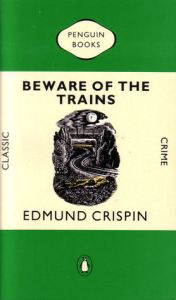
Goose
An enjoyable seasonal example from Conan Doyle for this entry, with ‘The Adventure of the Blue Carbuncle’ (1892), in which a jewel theft goes horribly wrong. A goose does not make for suitable hiding place for loot.
Gorilla
In Erle Stanley Gardner’s zoo based mystery, The Case of the Grinning Gorilla (1952), Perry Mason and his associates have to investigate whether or not a gorilla can be tricked into or trained to kill humans. Also this is a homonym but I could not resist including another of Michael Innes’ animal descriptions in The Weight of the Evidence (1944): ‘guerrilla cats.’

Hare
It was Jonathan who suggested Michael Innes’ Hare Sitting Up (1959), the title for which comes from a quote by D. H. Lawrence.
Hedgehog
Given the Puzzle Doctor’s love of all things John Rhode, he’ll be pleased with this entry as in The Ellerby Case (1927) a murderer puts poison on a hedgehog’s spines in order to kill someone.
Horse
Horses are often in the background of mystery novels, especially countryside set ones. Sometimes killers try to spook horses into bolting so their riders fall off and die, such as in The Choice (1931) by Philip Macdonald, whilst in Stuart Palmer’s The Puzzle of the Red Stallion (1936) a horse named Siwash is the only witness to the murder of a model in Central Park. The horse who comes back alone without its rider, is also a scene fairly familiar in fiction and film, with one such incidence taking place in Arthur Upfield’s The Bone is Pointed (1938). Helena in the comments section has also helpfully pointed a few more horse based mysteries: Josephine Tey’s Brat Farrar (1949), (how could I have forgotten that one?!), Gladys Mitchell’s The Twelve Horses and the Hangman’s Noose (1956), as well as Agatha Christie’s Endless Night (1967), Arthur Conan Doyle’s ‘The Adventure of Silver Blaze’ (1892) and Margery Allingham’s Look to a Lady (1931), in which Albert Campion nearly meets his end due to an overly aggressive horse. To this list Jonathan adds Erle Stanley Gardner’s The Case of the Fan-Dancer’s Horse (1947).

Iguana
This was an especially difficult category to fill, there being a lack of mystery novels featuring an Ibex or an Ibis, yet thankfully I came across Linda O. Johnston’s The Fright of the Iguana (2007), a pet siting mystery in which an Iguana gets kidnapped in Southern California.
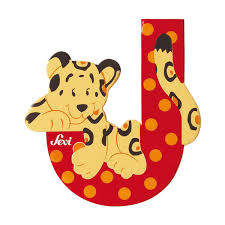
Jaguar
My example for this animal comes from the arena of children’s mysteries, as in Ron Roy’s The Jaguar’s Jewel (2000), Dink, Josh and Ruth Rose have to find who has stolen an emerald from a jaguar statue in a New York museum, in order to save Dink’s uncle from being wrongfully accused.
Jellyfish
This is a bit of a spoiler entry this one, but J is not the easiest of letters to fulfil, but I couldn’t not include Conan Doyle’s ‘The Adventure of the Lion’s Mane,’ (1926) in which a jellyfish has a very prominent role shall we say.

Kangaroo
Another amusing description of a human, in Raymond Chandler’s Playback (1958): “There was nothing to it. The Super Chief was on time, as it almost always is, and the subject was as easy to spot as a kangaroo in a dinner jacket.”
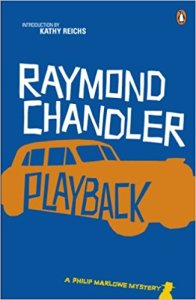
Kitten
This is a little bit of a sneaky one I know but K is another hard letter to complete. Erle Stanley Gardner’s prolific writing career comes to the rescue, with his The Case of the Careless Kitten (1942), in which a Siamese cat becomes a helpful clue in solving two murders.

Lion
Whilst there might not actually be a live lion in Pamela Branch’s The Lion in the Cellar (1951) and the lion in Agatha Christie’s ‘The Nemean Lion’ (1947) may only be a Pekinese dog, in Jack London’s ‘The Leopard Man’s Story’ (1906), we definitely have a lion caused human fatality – yet is there more to it? Also in Huxley’s Murder on Safari (1938), a murderer tries to divert suspicion through the presence of a lion in the vicinity of the corpse. A more unusual example suggested by Roger is Peter Dickinson’s A Pride of Heroes (1969), which takes place at a country house which has been turned into a theme park and features a man eating lion by all accounts. Finally “Sherlock” (one presumes a pseudonym, otherwise life got a bit too metafictional), also reminded me of Brian Flynn’s The Spiked Lion (1933), in which a victim seems to have been savaged by a beast, but actually poisoned by cyanide.

Macaque
It was Jeremy in the comments section which put me on to the Barbary Apes/Macques, which appear in Uneasy Relations (2008) by Aaron Elkins.
Monkey
In both my examples for this entry the monkey is a pet one, belonging to a private individual. The monkey in Miles Franklin’s country house spoof mystery, Bring the Monkey (1933), certainly wins the prize for the longest and most peculiar name: Percy Macacus Rhesus y Osterly. Whilst the monkey in Rutland’s Bleeding Hooks (1940) has a more sinister role, being found at the crime scene, hitting the corpse in the face. Noah has also brought to light another monkey example with ‘The Squirt and the Monkey’ (1951) by Rex Stout

Newfoundland (Dog)
The difficulty in fulfilling this category surprised me but after much searching I came across the second novel in Maggie Pill’s sister sleuth series, 3 Sleuths, 2 Dogs, 1 Murder (2014), with one of them owning a Newfoundland dog. Another sneaky entry perhaps but if I have happened to miss a book which includes a Narwhal, a Numbat, a New Guinea Singing Dog or the such like do let me know.
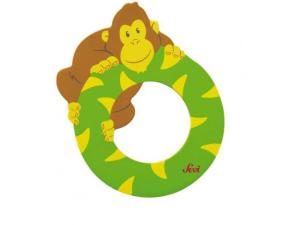
Octopus
An entry included for this cover picture a lone for Lester Dent’s The Feathered Octopus (1937)…
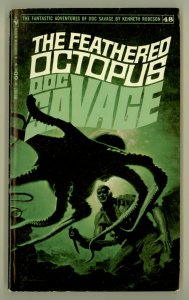
Jeremy also reminded me of the famous ‘octopus of fate,’ which metaphorically influences the mad escapades Leonidas Witherall gets up to in the 8 books by Alice Tilton.
Orangutan
One of the earliest and most memorable mystery stories, so yes another spoiler, we have ‘The Murder in the Rue Morgue’ (1841) by Edgar Allan Poe. It might not be the most plausible of solutions but it is hard to forget and certainly has a surprise quality to it. A less well known example, given by Roger, is Evelyn Waugh’s Work Suspended (1951), is a made up book referenced in the story, which includes a left handed orangutan committing a murder. Bonus points for meta-fiction definitely deserving I feel.
Ostrich
Despite Colin Curzon’s The Case of the Eighteenth Ostrich (1944) being a spy ring/espionage mystery, it also surprisingly commits a lot of page space for the hunting of a stuffed ostrich.

Owl
An owl costume is the disguise used by a thief in Max Adams’ Owl of Darkness (1942).

Parrot
Both in Erle Stanley Gardner’s The Case of the Perjured Parrot (1939) and Earl Derr Biggers The Chinese Parrot (1926), a parrot complicates and explicates a murder. Bev Hankins also uncovered the The Avenging Parrot (1930) by Anne Austin, which has a parrot as witness and The Purple Parrot (1937) by Clyde B Clason, in which a terracotta statue of a purple parrot is involved.

Penguin
Stuart Palmer’s The Penguin Pool Murder (1932) was one of the first mysteries I thought of when planning this piece and Hildegard Withers certainly gets more than she bargained for when she decides to take her pupils to see the penguins at the local zoo and finds a corpse in their pool.
Pigeon
New entry added on the back of a twitter query for crucial depictions of pigeons. Well unsurprisingly there are a number of pigeon themed titles, used in the figurative sense such as Cat Among the Pigeons (1959) by Christie and A Pigeon Among the Cats (1974) by Josephine Bell. In one instance I found the mention of pigeons in terms of jewels with M. McDonnell Bodkin’s Pigeon Blood Rubies (1915). There is also of course a man named Mr Pigeon in The Sunday Pigeon Murders (1942) by Craig Rice, but the most literal example I could find was a poisoned pigeon pie in the aptly named The Pigeon Pie Mystery (2012) by Julia Stuart.

Quail
When I first posted this list I had not had much or quite frankly any success in finding any Q animas in mysteries. Thankfully GAD fan Jamie emailed me the information that quails feature a lot (mainly in meals) in Paul Doherty’s Hugh Corbett series and also feature in Doris R. Meredith’s Sheriff and the Pheasant Hunt Murders (1993). All of which sounds a lot more plausible than me hoping there might be a Queen Bee or Quagga based mystery.
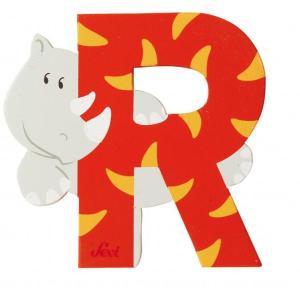
Rabbit
When I first came across Aaron Marc Stein’s Death Meets 400 Rabbits (1953), I immediately had visions of crime fighting rabbits or some kind of rabbit apocalyptic takeover of the world. So when I actually tracked down the blurb for this book I was a little disappointed to find out it was a night club murder and apparently ‘in Acapulco 400 rabbits was the term for ultimate saturation – a total binge.’ Another rabbit mystery I came across was E. and M. A. Radford’s Death of a Peculiar Rabbit (1969) in which a bank robbery is partially resolved it seems due to a rabbit ‘that seemed to have loped from a bank in Hampshire to a woodland in Surrey.’ As to how it achieves this end I do not know.
Rat
New category based on Roger’s knowledge of the Peter Dickinson canon, with the suggestion of Walking Dead (1977), a more horror/mystery novel centred on a laboratory in which there is a white rat.
Raven
Whilst this bird may conjure up more visions of Edgar Allan Poe, or the maiden name of the wife of Michael Innes’ serial sleuth Appleby, my selection for this entry is actually Gladys Mitchell’s The Croaking Ravens (1966). In this story, which is set at a castle, there is a lot of folk tales, legends and lore involving the heraldic ravens, linking the castle’s owners to a past of murder and mystery.

Sea Lion
Alan Melville is a writer whose work I have only encountered 3 times, but I would say his circus based mystery Death of Anton (1936) is his best, not least because of the wide variety of humour this story includes. One of the most hilarious yet absurd moments is when a priest is sitting next to a sea lion called Horace at a bangers and mash party. It sounds too ridiculous to work but I promise you it really does. Another sea lion example I came across is in a 1940s play, 13 to the Gallows, written by Carr and Val Gielgud. This play is set at a radio studio and during one of its variety hours, a man is given the chance to try and proof his innocence for a crime he was acquitted of years before and during this variety hour there is indeed some performing sea lions.

Shark
Gladys Mitchell’s Mrs Bradley is often described using quite a wide range of unusual animals, but it wasn’t until preparing this post that I found she is also likened to a shark in Dead Men’s Morris (1936). We are privy to the thoughts of the police suspect, whom Bradley defends and in these doubtful thought he feels that “to bring this terrible little old woman into the heart of his affairs was rather like asking a shark to defend one from cannibals. The shark might, and, he was certain, could eat the cannibals — in this case that particularly nosey inspector of police — but would it not turn upon him and engulf him also as a kind of relish to the meal?”
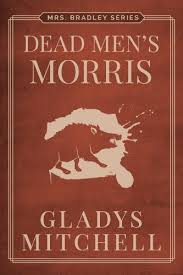
Sheep
My first vintage example for this animal is more of an outside of the box one, as I felt that Ngaio Marsh’s Died in the Wool (1942) should count. After all if it was not for the sheep, then no wool would have been gathered, meaning no place for the book’s victim to be compressed into. However I am on much surer ground with Leonie Swann’s Three Bags Full (2005), in which a flock of sheep set out to investigate who murdered their shepherd. I also think Arthur Upfield deserves a brief mention as sheep stations are often settings in his Napoleon Bonaparte mystery novels, such as The Barrakee Mystery (1929).

Snakes
Snakes are another popular category with such reptiles being included in titles like The Snake on 99 (1959) by Stewart Farrar, Snake in the Grass (1954) by Anthony Gilbert and Sheiks and Adders (1982) by Michael Innes. However snakes have more of a role in Conan Doyle’s ‘The Adventure of the Speckled Band’ (1892), Gladys Mitchell’s Come Away Death (1937) and in John Dickson Carr’s He Wouldn’t Kill Patience (1944), in which a death that looks like suicide, is suggested to be otherwise due to the victim’s daughter being sure her father would not have killed himself in such a way that his beloved snake, Patience, would also have died.

Skunk
As great as it would have been to find a mystery novel with an actual skunk in, I did come across a short story by Joseph Commings, called “The Whispering Gallery” (2004), in which it is written that “Banner scoffed. ‘The Great Zeno! Gives himself top billing! He’s the kind of a guy who takes skunks outta his hat instead of rabbits!’” This story is part of a collection called Banner Deadlines: The Impossible Files of Senator Brooks U Banner.
Spider
I came across Koga Saburo’s short story, ‘The Spider’ (1930) in Foreign Bodies (2017), which was edited by Martin Edwards and is a collection of translated vintage mystery short stories. This is a very sinister and creepy story set at a remote laboratory built for the purpose of studying spiders. Suffice to say it is not the spiders which are the most dangerous thing there. Santosh has also helpfully supplied me with another spider related story by Paul Halter called La Toile de Penelope (2001).

Tarantula
My entry for this category also came from Foreign Bodies (2017) and whilst there might be no live tarantulas in Sharadindu Bandyopadhyay’s ‘The Venom of the Tarantula’ (1933), we do see one old man’s very cunning ploys to access highly addictive tarantula juice.

Tiger
Tigers are often used figuratively in mystery titles, such as Margery Allingham’s Tiger in the Smoke (1952), to hint at danger or peril, but the most memorable instance of a tiger in a mystery novel for me, is Melville’s Death of Anton (1936). It is mostly a hilarious comedy, but Melville does add a significant element of pathos and darkness with the circus’ tiger group. Another reason why it was such a good read.
Tortoise
I was quite pleased when I came across Elizabeth Ferrars Hunt the Tortoise (1950), as it seems that the disappearance of a pet tortoise named Zizi enables the murderer to enact an element of their murder plot during the search.

Unicorn
We have definitely moved into the realms of mythical animals now, but mysteries with a Uakari, an Urial or a Unau, are a bit thin on the ground. So yes I have decided to include Carter Dickson’s The Unicorn Murders by (1935), in which a victim’s head looks as though it has had a run in with a unicorn.

Viper
Back on to safer ground we have John Farr’s The Lady and the Snake (1957), in which an escaped Gaboon Viper might be responsible for the death a multi-millionaire reptile collector. Farr, (aka Jack Webb), also wrote a mystery novel called Don’t Feed the Animals (1955), which is set at San Diego Zoo. However I have not been able to uncover what role animals play in this book.
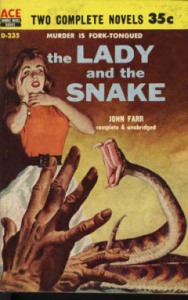
Vulture
The title which first came to mind was Todd Downing’s Vultures in the Sky (1935), however I think these birds have a slightly bigger role in Huxley’s Murder on Safari (1938), in which they are hovering around the corpse of Lady Baradale. Given the setting, the response and presence of animals in and around this murder victim are classed as important.

Wasp
Christie fans will of course remember the much maligned wasp, which features in Death in the Clouds (1935). Thankfully Poirot is able to clear its name, as well as his own of the murder. Les Blatt at Classic Mysteries also brought to my attention that wasps (as well as bees and hornets) feature a lot in Edmund Crispin’s Holy Disorders (1946), which I can’t believe that I forgot.

Again this was a letter I had to admit defeat with but I am delighted to have come across such a thing as an x-ray tetra fish. Surely some fish enthusiast could rustle up an Amazonian mystery with such a creature?

Yabby
Not heard of a yabby before? Neither had I, but apparently it is a type of crayfish and in Wimmera (2017) by Mark Brandi, two of the protagonists enjoy catching these creatures and it is out of this river they find a body. The discovery of this creature also meant I didn’t have to cheat with the Maigret and the Yellow Dog (1931) by George Simenon.

Zebra
Alas I did not come across a mystery novel with a zebra in it, but I did find Ross Macdonald’s The Zebra Striped Hearse (1962).
Zoo
There are quite a few zoo set mysteries, some of which I have already talked about, but here are a few others: Antidote for Venom (19380 by Freeman Wills Crofts, The Man Who Was Not There/ The Man Who Loved Lions (1943) by Ethel Lina White, The Mystery at Antwerp Zoo (1928) by Stanislas-Andre Steeman and Sintair and The Zoo Murder (1926) by Francis Grierson. There is also a mystery novel by John Franklin Bardin called Devil Takes the Blue-Tail Fly (1948), which concludes with a showdown in a bear pit and yes someone does indeed not come back out of there alive.

Fun post!
Just this week I read ESG’s The Case of the Lame Canary. If you want more monkeys, there’s a pet monkey in a Nero Wolfe novel, and some incidental monkeys (aka “Barbary apes”) in the Gideon Oliver book set on Gibraltar. As for octopuses, don’t forget Leonidas Witherall’s metaphorical “octopus of fate”! (:v>
LikeLiked by 1 person
There’s actually two Nero Wolfe short stories that contain a pet monkey. One is “The Squirt and the Monkey” and the other is “Cordially Invited to Meet Death” — okay, that one contains a chimpanzee named Mister. But I’m not sure why you suggest that Archie was fibbing about tripping over an alligator and scratching his hand in the same story. It’s a real alligator, its name is Moses, and the scratch is actually relevant to the story.
LikeLiked by 2 people
Thanks Noah. I was working with limited info so have corrected the alligator entry accordingly. Not sure why I thought it was a fib, but I guess it did sound like a wild story Archie or Nero might cook up to confuse the police.
LikeLike
Thanks for other monkey example. I was thinking that should be another popular category.
LikeLiked by 1 person
Another bee entry for you (a little beyond Golden Age): Sheila Pim’s (A) Hive of Suspects (1952)
LikeLiked by 1 person
Can’t believe I thought this one, as I have read other Pim books.
LikeLike
Additional parrots as well:
The Avenging Parrot by Anne Austin, 1930 (a parrot is the only witness to murder)
The Purple Parrot by Clyde B. Clason, 1937 (a terracotta statue of a purple parrot figures prominently)
LikeLiked by 2 people
Gosh parrots are popular, especially as witnesses. I guess it is because they can remember speech. Thanks for these other examples. I’ll hopefully be adding them into the post soon. Just thought I’d give it a couple of days so I can do the editing in one go.
LikeLiked by 1 person
In another mystery that I read recently (which I won’t mention by title–because this is a minor spoiler of sorts), the presence of a parrot is highlighted in such a way that I expected it to chime in at some point and repeat incriminating speech. This never happens, though, so the parrot is a red herring, if you will (though my impression was that it wasn’t so much an intentional r.h. on the part of this author as an example of his typical untidiness with subplots).
LikeLike
Spiders feature prominently in Paul Halter’s La Toile de Penelope. Here also, they are not the most dangerous . A human being is more dangerous than them !
LikeLiked by 1 person
Thanks Santosh!
LikeLike
Great post. Spoiler, but a spider figures in “The Episode of Torment IV” by C. Daly King in THE CURIOUS MR TARRANT. THE GREEN EAGLE is Lester Dent writing as Kenneth Robeson a Doc Savage adventure, and the green eagle is, if memory serves, a little pocket game. Ellery Queen dealt with SEVEN BLACK CATS and a TWO-HEADED DOG in his ADVENTURES. Judge Dee has a couple of cases in THE MONKEY AND THE TIGER that deal with…well, a monkey and a tiger. Lew Archer had a case called SLEEPING DOG and you could have used falcon for F with THE MALTESE FALCON. I’m sure there are others, but these are what came to mind as I read your post. Good job!
LikeLiked by 2 people
Some good examples. Can’t believe I missed out falcon and the Dee novel, but my brain might have become a bit boggled after all the internet research I had done.
LikeLike
Congratulations on your 700th – and on an incredible post: my mouth dropped open when I realized you were finding more than one entry for so many letters! I might be able to think of more animals, but am too over-awed by your achievement right now!
LikeLiked by 1 person
haha thanks yes much googling did ensue.
LikeLike
Peter Dickinson scores quite a few: a (possible) deer in HINDSIGHT, a chimpanzee witness in THE POISON ORACLE, a white rat in WALKING DEAD and a man-eating lion in A PRIDE OF HEROES, plus quite a few more in the titles..
In WORK SUSPENDED by Evelyn Waugh there is a book in which a left-handed orang-utang commits a murder, but the book itself is fictional,
LikeLiked by 1 person
Loving that final example. Ought to get bonus points really for being a novel in a novel.
LikeLike
[…] via 700th Post: An A-Z of Animals in Mystery Fiction […]
LikeLike
This is a suitably epic way to mark your blogging achievement! Congratulations on the milestone and on finding so many animals in mystery novels. Some intriguing animal references here and I am always happy to see a Death of Anton reference!
LikeLiked by 1 person
Thanks and yes Death of Anton definitely is worth the two mentions. By far Melville’s best book (that I’ve read anyways).
LikeLike
Congratulations on 700 posts, and you must not be a crossword puzzle fan.
In thousands of puzzles, Asta, the dog from Dashiell Hammett’s “Thin Man” books/movies shows up as an answer.
The little beast is inescapable.
LikeLiked by 1 person
Well he escaped me lol Someone on FB also mentioned Asta, so when I add in the new info I’ve received from commenters he’ll get fitted in.
LikeLike
Speaking of Facebook, armchairreviewer, I’d be glad to connect with you there. Recently I’ve been featuring a lot of little excerpts from the Perry Mason books–discussing, for instance how ESG was apparently writing for the benefit of extraterrestrials (based on the things he feels obliged to explain to the reader). You can find me there as Jonathan Caws-Elwitt, and the more the merrier.
LikeLiked by 1 person
Are you in the Facebook GAD group? Great place to discuss vintage mystery fiction, including ESG. Got quite a lot of members in too, so new topics/titles and authors are always coming up for discussion.
LikeLiked by 1 person
Thanks for the tip! I’ve just put in a request to join.
LikeLiked by 1 person
Hooray! Look forward to discussing all things GAD with you there.
LikeLike
Congratulations on a significant achievement – 700 posts is a lot of work. And the quality of your posts stand out – fine reviews and interesting studies. Let me add to this one by pointing out three fine insect types – bees, wasps AND hornets – all of which play a very significant role in Edmund Crispin’s “Holy Disorders.” Congratulations again – now start working towards 800!
LikeLiked by 1 person
Thanks! Gosh can’t believe I forgot that Crispin title. It’s weird which books came straight to mind and which ones I forgot.
LikeLike
How many of the 700 posts have been reviews?
LikeLiked by 1 person
Not sure to be honest. If I ever get bored enough to count them all I’ll let you know.
LikeLike
Horses feature heavily in Josephine Tey’s Brat Farrar and Gladys Mitchell’s Twelve Horses and the Hangman’s Noose. A-horse-as-a-murder-weapon plot device is used in Agatha Christie’s Endless Night. Then, of course, there’s Conan Doyle’s Silver Blaze. And in Margery Allingham’s Look to the Lady the villain tries to dispose of Albert Campion by locking him in a stall with the murderously inclined horse.
Dogs are quite numerous in detective fiction. I’d like to mention Rex Stout’s novella Die Like a Dog, in which a black labrador plays a significant role (and Nero Wolfe almost becomes a dog owner!) There’s another Rex Stout, In the Best Families, where one of the characters breeds dobermans. They are not just in the background, either; one of the dogs is quite instrumental to the story. And an honourable mention goes to Mr. Merrythought (who is anything but) – a bloody-minded bloodhound from Edmund Crispin’s Love Lies Bleeding (gosh, there’s a lot of ‘blood’ in this sentence, isn’t there?), who gets his moment in the limelight towards the end of the book.
Assorted cattle features prominently in yet another Rex Stout, Some Buried Caesar, whose plot revolves around a famous prize bull.
A cat provides a key clue to the mystery in Erle Stanley Gardner’s The Case of the Caretaker’s Cat.
LikeLiked by 1 person
Gosh you know your Stout don’t you. Not read much of his work, but based on your information he seems to have included animals in quite a creative way into his books.
LikeLike
Interestingly, it’s been well over a decade since I last read any of his books. I’ve only ever read a few, but, by sheer coincidence, almost every one of them had something to do with animals. Your murder mystery menagerie must have triggered my memory)))
LikeLiked by 2 people
haha well as long as their good memories that’s alright.
LikeLike
You could add Michael Innes’ Hare Sitting Up, and Erle Stanley Gardner’s TCOT Fan-Dancer’s Horse, plus Margery Allingham’s Cargo of Eagles.
LikeLiked by 1 person
Thanks!
LikeLike
A lion featured in The Spiked lion by Brian Flynn, which puzzle doctor recently reviewed.
LikeLiked by 1 person
Thanks. Well spotted. Surprised how many lions are cropping up in mystery fiction.
LikeLike
Literary lions!
LikeLiked by 1 person
That reminds me: there is a novel called The Man Who Loved Lions by Ethel Lina White. I have not read it yet, but judging from its description it fits more than one category. I’ll quote the blurb: “In the depths of the English countryside, Sir Benjamin Watson has amassed a private zoo in the grounds of his country home, ‘Ganges’ – an exotic jungle filled with snakes, elephants, tigers and lions. One summer evening during the Blitz, Ann Sherborne arrives at Ganges for a long-expected reunion of university friends. As tensions mount among the reunited companions, a series of accidents involving the zoo animals leads Ann to suspect that someone among them is hatching a sinister and dangerous plot.”
LikeLiked by 1 person
Yes that White novel is a good one and is mentioned in this post under zoo. Reviewed the novel a couple of years ago on the blog. Life lesson: Never accept an invitation to a private zoo at night, especially during a black out.
LikeLike
Oh, I didn’t realise it was the same novel. Alternative titles can be so confusing! Glad to hear that it’s good, though, as it’s on my TBR list. Sounds really intriguing.
LikeLike
I’ve added both titles now as your title is the more demonstrably animal related.
LikeLike
I am late to this post but that is for the best as I can see all the suggestions in the comments. And congratulations on 700 posts.
LikeLiked by 1 person
Thanks and yes all the extra suggestions have been great. Helped to flesh out the list further.
LikeLike
[…] were looking at some of the best detectives, (in our own opinion of course), as well as celebrate my 700th blog post by looking at animals in mystery […]
LikeLike